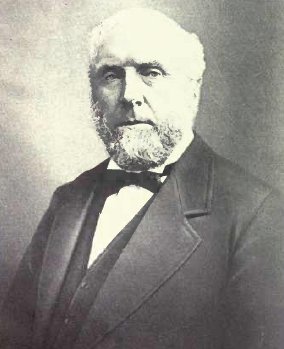 Roderick Finlayson, a Scotsman by birth, served the Hudson’s Bay Company in various posts across Canada before being sent to the fledgling Fort Victoria in 1843 (Stardom, para. 2). He became the officer in charge the following year (Stardom, para. 3), taking over the project of growing the settlement and colonizing the land with "English farms” (Finlayson, History 10) and displacing Indigenous Peoples who stood in the way. To incentivize the colonial dominance over the land, HBC offered deals on the land to HBC officers, which allowed Finlayson to become very wealthy over the course of his life in Victoria from acquiring and extracting resources from the land (Stardom, para. 5).
Roderick Finlayson, a Scotsman by birth, served the Hudson’s Bay Company in various posts across Canada before being sent to the fledgling Fort Victoria in 1843 (Stardom, para. 2). He became the officer in charge the following year (Stardom, para. 3), taking over the project of growing the settlement and colonizing the land with "English farms” (Finlayson, History 10) and displacing Indigenous Peoples who stood in the way. To incentivize the colonial dominance over the land, HBC offered deals on the land to HBC officers, which allowed Finlayson to become very wealthy over the course of his life in Victoria from acquiring and extracting resources from the land (Stardom, para. 5).
As a colonial officer for HBC, Finlayson took the approach of using intimidation and fear to control and suppress Indigenous Peoples in the colony. Characterizing them in his autobiography as “wild savages” (Biography 14), “a wild turbulent race” (8), and “treacherous Indians” (17), he used displays of violence and prowess to intimidate them into submission. He recounts how he had a Chief bring an old canoe into the harbour for him to shoot with guns to illustrate what would happen if the white settlers were attacked, writing, “Thus these wild savages were taught to respect British justice” (14). He tells a similar story of requesting Captain Courtney to bring troops and warships into the harbour to “show the Indians what a man of war was” (17), concluding that “this display of arms from the [HMS] Constance had a good effect on the natives, as they were evidently afraid to pick any quarrels with us for some time afterward” (18). When the colonists of Fort Victoria suspected that their Indigenous neighbours had killed an ox grazing outside of the colonists’ settlement, Finlayson fell back on threats of violence to force the Songhees to pay for the ox by shooting a cannon at the Chief’s empty home (12-13). He writes, “I then fully explained to them that I had it in my power to destroy all their houses and kill many of them” (History 12). He concludes, “I knew our guns would bring them to their senses” (Biography 13). Finlayson reveals that he would have preferred to use actual violence rather than threats of violence, but was restrained by HBC’s orders: “My first instinct in dealings with the Indians... was to fire upon them too, but we were restricted in the course, by our orders & instructions… The natives here & on the Sound were considered a cruel & treacherous set & they would be now too, but for fear of the whites” (History 61). Finlayson resorted to threats and fearmongering in his dealings with the Indigenous inhabitants of Vancouver Island.
His autobiography makes it clear that Finlayson knew the Songhees wanted the English settlers gone: at one point, the Songhees people set fire to the settlement, and assert that the land belongs to them (Biography 13). This act of revolt against the colonists initiates “a great deal of angry parleying on both sides,” leading to the displacement of the Songhees from their original homeland to a reserve away from where the English were growing their colony (13). As established by the many stories of the English settlers’ displays of power and threats of violence, it is clear that these negotiations could not have been between two groups on equal footing.
Mount Finlayson, Victoria, B.C.
Finlayson St, Victoria, B.C.
Finlayson Point, Victoria, B.C.
Finlayson Channel and Roderick Island, Milbanke Sound, B.C.
Millstream, BC named after the mill Finlayson built in the area
